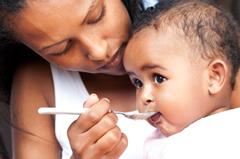The Social Context of Food course


As healthcare practitioners we often feel we know what infants and young children should be eating, but the families we work with can experience barriers in putting this information into practice. In our day-to-day practice, we need to consider the social aspects of food and the effect that our environment has on our food choices.
This session was reviewed by Amanda Avery and updated in February 2017.
Learning Objectives
By the end of this session you will be able to:
- Describe the variability in how families organise eating according to religious, cultural and socio-economic circumstances
- List the external influences on families’ food choices
- Describe the benefits of family mealtimes and parental role modelling
To improve nutritional intakes of families and communities, healthcare practitioners (HCPs) need to help families change their eating habits. To do this, HCPs require an understanding of why and how families make their food choices and engage in particular feeding practices.
Lisa worked as a Paediatric Dietitian for Calderdale and Huddersfield NHS Trust in West Yorkshire for nine years before starting as a freelance Peadiatric Dietitian after moving back to Aberdeenshire in early 2008.
Her special interests are obesity, feeding problems and poor growth.

- Anaesthesia Fundamentals | Physiology | Ventilatio...
- Posted By eIntegrity Healthcare e-Learning
- Posted Date: 2024-12-26
- Location:Online
- This session describes how and why ventilation and perfusion vary in the healthy lung. Causes of hypoxia, such as hypoventilation, increased dead space and shunt, are discussed to help the trainee explain and manage hypoxia clinically.
- Anaesthesia Fundamentals | Physiology | Pulmonary ...
- Posted By eIntegrity Healthcare e-Learning
- Posted Date: 2024-12-26
- Location:Online
- This session covers the measurement and clinical importance of lung volumes, including functional residual capacity and dead space. Information regarding the performance and interpretation of flow-volume loops is also included.
- Anaesthesia Fundamentals | Physiology | Co2 Carria...
- Posted By eIntegrity Healthcare e-Learning
- Posted Date: 2024-12-26
- Location:Online
- This session covers the physiology of how carbon dioxide is carried by blood, including its conversion into bicarbonate ions and the role of the red blood cell and haemoglobin in this process. The session also describes how buffers work, and the fundament
- Anaesthesia Fundamentals | Physiology | Function o...
- Posted By eIntegrity Healthcare e-Learning
- Posted Date: 2024-12-26
- Location:Online
- This session focusses on the function of haemoglobin in oxygen (O2) carriage from the lungs to other tissues where cells are supplied with the O2 required for oxidative phosphorylation in the mitochondria. We will cover the structure
- Anaesthesia Fundamentals | Physiology | Gaseous Ex...
- Posted By eIntegrity Healthcare e-Learning
- Posted Date: 2024-12-26
- Location:Online
- This session will introduce you to the physiological effects of altitude and the adaptations that occur with acclimatization. It also introduces the pathology and physiology of high pressure and decompression.








